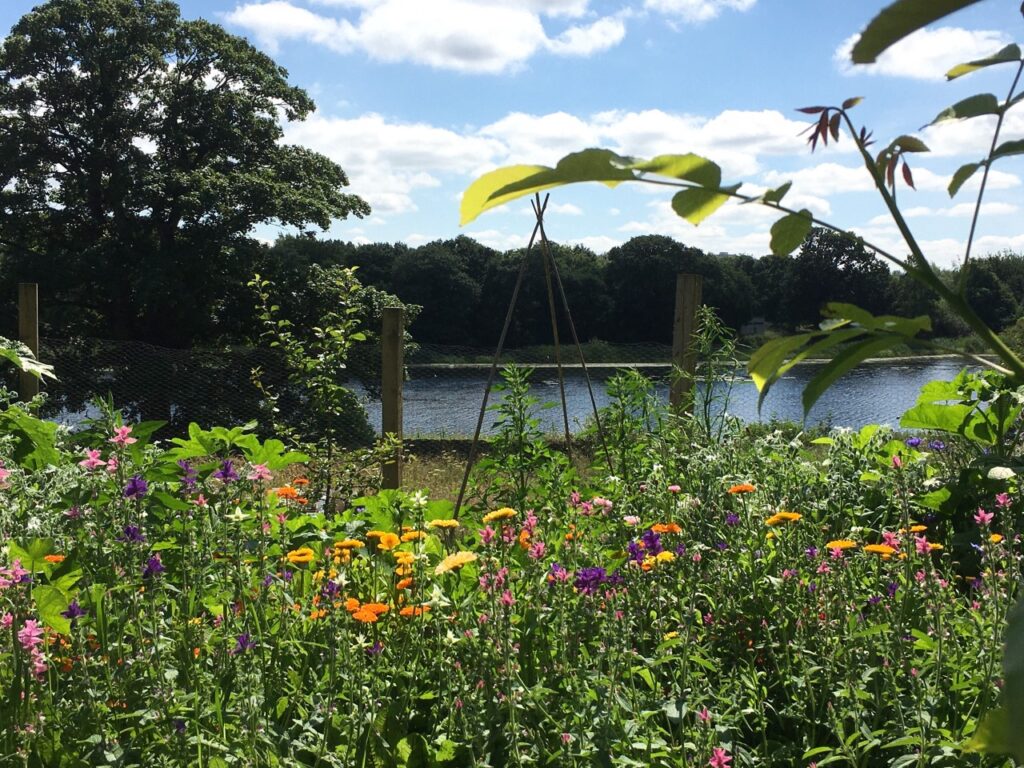We grown mixed leaf salad here in the Gairden and its been getting good reviews from our customers at the Greens To Go stall,
“Recommend the veggies from Jock Tamson’s, the salad leaves were not only delicious but had flower petals, so wonderful for presentation. Will be doing this again”.
Nothing looks nicer with salad than a colourful sprinkling of edible flowers, and many contain vitamins, so we try to grow as many varieties as possible; the bed also makes for a glorious view from our Bothy at tea-break time.

The edible flower bed
I’ve always enjoyed growing things that are unusual enough to catch the eye and to entice people to eat things that they might never have considered before. This started for me when I was gardening at the Camas Outdoor Centre on Mull where part of the job was to entice young people to try eating veg when many of them were highly suspicious of anything green. Actually showing them a tomato growing in the polytunnel, for example, was enough to reel them in.
All of the flowers described here are very easy to grow and can mostly be started in modules in a cold frame or sown direct. All of the seeds are readily available, cheap to buy and easy to collect after the plants have flowered. I hope you’ll try your hand at your own edible flower border.

Volunteer with Calendula 
Calendula
Calendula (calendula officinalis)
Also known as the ‘pot marigold’ this lovely daisy-like bloom comes in a variety of bright yellows and oranges. This hardy annual is very easy to grow and will readily set seeds for next year which means you’ll find lots of wee seedlings appearing in the bed the following year. Just gently pull off the seedlings and sprinkle over your salad or put a couple of whole flowers on the side of your head. Calendula also has several medicinal uses but I’ll leave that to you to research yourself. Modelling the Calendula today is one of our fabulous hard-working Gairden volunteers.

Volunteer with Clary 
Clary
Clary sage (salvia sclarea)
Modelled for us here by another marvellous volunteer – he leaves us all standing when it comes to digging power! He is always cheerful, despite claiming that he never smiles for photos….
Clary is a tri-coloured beauty and a member of the sage family but doesn’t have the same in-your-face smell as its common cousin. The colourful parts are actually bracts whilst the flowers are tiny and white. This one has a long history with its medicinal uses being mentioned by Pliny. A short-lived perennial, it is best grown as hardy annual and either started off in a cold frame or sown directly; it soon grows a glorious display of colours.
Btw, the name ‘clary’ originates from the practise of using the sticky seeds to remove foreign object from the eyes and hence help you to see ‘clearly’. While that’s a fascinating bit of etymology, I wouldn’t recommend trying this at home, no really – use water!

The Rev. Dr Jim Jack with Nasturtiums 
Nasturtiums
Nasturtiums (tropaeolum majus)
I nabbed the Rev Jim Jack whilst he was passing because I reckoned his blue clerical shirt would show these little beauties off to their best advantage. These are truly marvellous plants with so many uses – just grow them for their cheerfulness alone. All parts of the plant are edible: the flowers, the leaves (full of vitamin C) and the seeds (which can be pickled and used as a substitute for capers.) They attract beneficial insects such as bees; their strong scent repels certain pests and they can also be used as a sacrificial crop to encourage cabbage white butterflies to lay their eggs on their leaves and not on your brassica crops. ‘
They come in all sorts of bright colours, traditionally yellows and oranges but have a look for ‘Baby Rose’ a newer variety – a deep pink-red that looks fabulous in the salad . The various varieties also provide a range of leaf colours: dark blue ‘Blue Pepe’ to white/green variegation ‘Alaska Mixed’. They prefer poor soil – or else they’ll put a lot of effort into growing masses of leaves – so mix some of last years spent container compost in with the new stuff.
Incidentally their name – tropaeolum comes from the Greek ‘tropaion’ (a trophy) where the flowers were originally used for the trunk of a trees where the shields and helmets of a defeated army were hung: the leaves resembling the shields and the flowers the helmets. Who’d have thought this innocent wee blossom would have such a gruesome association?

Volunteer with Hollyhock 
Hollyhock
Hollyhock (althaea rosea)
This one is modelled for us by the volunteer you’re most likely to find concealed behind the jungle-like growth in the polytunnel, we think she enjoys the heat in there. This flower is an absolute big show-off! It comes in a huge variety of colours and can reach up to eight feet tall. It’s a short-lived perennial, so best grown as an annual, but will readily self-seed around the bed. All parts of the plant are edible and it has numerous medicinal uses. Just one of these big fancy blooms will enhance any plate, transforming a run of the mill dinner into a tropical delight….probably best with something fancier than mince and tatties though.
The name hollyhock – is said to come from the ‘holy’ land where the petals were used as a poultice on the ‘hocks’ of injured horses during the crusades. Jings, these flowers and their military origins.

Volunteer with Viola 
Viola
Viola (viola tricolour)
Shown here by another volunteer who claims not to smile for photos, I don’t know so much about that, but I do know that his cheery banter makes us all laugh a lot. This wee flower is, in my opinion, the prettiest of all small garden flowers with many varieties providing a great range of delicate colour. It’s a perennial but often looks quite scruffy by the end of the season so grow it as an annual starting the seeds under glass before hardening off and planting out. It will readily self-seed too. Again, this one has a wide range of medicinal properties one of which giving it the common name ‘Heart’ ease’ because a brew containing the flowers was thought to ease a broken heart: hmm, don’t’ try this one at home.
The flowers will make any salad or dish look very posh indeed. There are lots of varieties to try, I’d recommend ‘Jump up Johnny’ and ‘Chickychicks’.

Volunteer with Borage 
Borage
Borage (borago officinalis)
Modelled for us by a visitor to the garden who I met whilst she sorting out her wee boy’s shoe laces whilst cradling her new baby. I first met this lovely woman when she and her husband were celebrating their wedding in the Garden Room a few years back.
This prolific plant gets its name from latin ‘burro – a hairy garment’, describing the furry, slightly jaggy leaves. Both the blue and the white varieties are hugely attractive to bees and therefore encourage pollination in your garden. Top tip: when you’re picking the flowers, take care to shake the plant first to make sure you don’t get stung – I speak from personal experience here.
Again, this one has many medicinal uses with its most famous being ‘Starflower Oil’ – widely available to purchase, it is full of gamma linolenic acid which helps regulate hormones – for all you premenstrual and menopausal folks out there.
As well as looking fab in the salad, you can also set the flowers in ice cube trays for adding to drinks.
This is a hardy annual and is very easy to grow. Caution: will self-seed like mad – pull it out if it’s in the way or leave the odd one to act as a pollinator amongst other crops.

Claudia with Sunflower 
Claudia with Sunflower
Sunflower (Heliantus anuus)
Here we have Claudia from Dr Neil’s Garden demonstrating that these are truly edible. The helio (sun) anthus (flower) gets its name from its bold good looks and from the fact that it is heliotropic, i.e. throughout the day the flowers turn their heads to follow the sun’s journey across the skies. Add to salads and garnishes by pulling the petals gently from the flower. Leave the heads on the plant to produce seeds to sow next season or to provide food for the birds. This one comes in a variety of colours ranging from the classic yellow all the way through oranges and reds to browns. Brown flowers? Really? I always associate them with 70’s wallpaper.
Originally cultivated as a crop by the indigenous people of North America, the sunflower is now widely grown for the production of oil. They are also widely grown in gardens the length and breadth of the nation, in fact I think it might be illegal not to grow them in a community garden.
The edible flower bed was built by our team of volunteers who made many, many trips across the field with loaded wheelbarrows. A huge thanks to Edinburgh University’s Edinburgh Local Community Grant Scheme for their donation which made the construction of the edible flower bed possible.
Lizz, project manager
